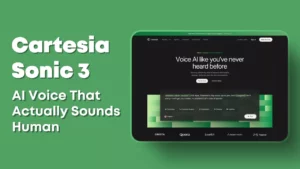
Remember when AI voices sounded robotic and awkward? Those days are over. Cartesia Sonic 3, launched in October 2025, is the first AI voice that genuinely sounds human. It laughs at jokes, switches between languages naturally, and responds instantly without those weird pauses that give away it’s a machine.
Karan Goel and the Team Behind Cartesia
Karan Goel, founder and CEO of Cartesia, studied at IIT Delhi and Stanford’s AI Lab. He pioneered State Space Models, a completely new way for AI to process information. His co-founder Albert Gu joined him from Stanford, where they developed breakthrough technologies called S4 and Mamba that revolutionized how AI systems handle sequential data.
Cartesia just raised $100 million from big players like NVIDIA and Kleiner Perkins. Companies like ServiceNow and Decagon are already using earlier Cartesia versions for customer calls. Karan Goel is so confident in Sonic 3 that he’ll donate $5,000 to your favorite charity if it can’t beat your current voice system.
What Makes Cartesia Sonic 3 So Special and Unique?
Cartesia Sonic 3 responds in 90 milliseconds, that’s faster than most humans react in conversation. The end-to-end response time is 190 milliseconds, which is three to five times faster than competitors. There are no robotic delays or awkward pauses.
But here’s the thing: speed doesn’t matter if it sounds terrible. Cartesia Sonic 3 nails both speed and quality. In demo videos, you can see it handling a restaurant reservation while someone interrupts mid-sentence. The AI adjusts naturally, understands context, pauses at the right moments, and even laughs when someone cracks a joke.
Control What You Need with Cartesia Sonic 3
Developers can fine-tune exactly how the Cartesia voice sounds:
- Add emotions like excitement, empathy, or drama
- Insert pauses down to the millisecond
- Adjust playback speed to 1.2x or whatever you need
- Control volume and pacing for different situations
State Space Models: The Tech Behind Cartesia
Most AI voice systems use Transformer models, the same tech that powers ChatGPT. Transformers are great for text, but they’re inefficient for voice because they have to review everything that happened before they respond. That creates lag.
Cartesia Sonic 3 uses State Space Models instead. Think about how you remember conversations. You don’t replay everything in your head, you just remember the context and keep going. That’s how State Space Models work. They maintain understanding without constantly backtracking, which means they can handle way more information without slowing down.
This State Space Models architecture, pioneered by Karan Goel and his team at Cartesia, is what gives Sonic 3 its unprecedented speed advantage. The results prove it. Cartesia Sonic 3 beats competitors on accuracy and consistently stays under 100 milliseconds latency. It generates audio and starts playing almost instantly.
Cartesia’s Multilingual Capabilities
Cartesia Sonic 3 supports 42 languages that cover 95% of the world’s economy, including English, Spanish, French, German, Japanese, Korean, and Chinese.
What’s really impressive is the Cartesia Indian language support:
- Hindi
- Tamil
- Bengali
- Telugu
- Gujarati
- Kannada
- Malayalam
- Marathi
- Punjabi
If you’re building products for the Indian market, Cartesia is huge. The demos show one voice switching from English to Hindi to Spanish without sounding weird or losing naturalness. Each language maintains proper accents without that awkward “English creep” where non-English words sound forced.
Smart Context Understanding in Sonic 3
Cartesia Sonic 3 automatically knows how to say abbreviations like NASA and FBI correctly. It doesn’t stumble over acronyms like older AI voices did. This makes conversations flow naturally instead of sounding choppy and robotic.
Clone Any Voice with Cartesia
This is where Cartesia Sonic 3 gets really interesting. You can create a voice clone from just 3 seconds of audio. Other systems need several minutes of clean recording. Cartesia gives you options:
- Instant clone: Create a voice from minimal audio
- Pro clone: Get deeper emotional range for professional work
- Custom design: Build voices from scratch by choosing traits like “warm storyteller” or “energetic host”
Content creators can narrate videos without recording every time. Businesses can build AI agents that sound consistent across thousands of calls. Game developers can create character voices. Brands can develop unique, recognizable voices for their Cartesia AI assistants.
Real Uses for Cartesia Sonic 3 Right Now
Cartesia is already powering real applications:
- Customer support that sounds empathetic and helpful
- Educational tools that work in multiple languages
- Accessibility features for people who need audio content
- Virtual healthcare assistants
- Voice interfaces for logistics services
For solo creators and small businesses, Cartesia Sonic 3 eliminates outsourcing voiceovers or spending hours recording. You can create professional audio content on your own schedule without sacrificing quality.
Safety Features Built Into Cartesia
Cartesia built in protections like voice watermarking and mandatory consent for cloning voices. These safeguards matter as the technology becomes more powerful and accessible.
How to Try Cartesia Sonic 3
Go to cartesia.ai/sonic and get 100,000 free credits to test everything. One character of text costs one credit.
Here’s the Cartesia pricing:
- Free: 20,000 credits to start
- Pro: $5/month for 100,000 credits
- Startup: $49/ month for 1.25 million credits
- Scale: $299/month for 8 million credits
The free tier gives you enough credits to thoroughly test Cartesia Sonic 3’s capabilities.
You can also deploy Cartesia on-premise or on-device, which gives companies more control over data and security. This matters for organizations with strict privacy requirements.
Final Thoughts – The Future of Voice AI with Cartesia
Cartesia Sonic 3 isn’t just an improvement,it’s a fundamental shift in voice AI. By using State Space Models instead of Transformers, Karan Goel and the Cartesia team created an AI that captures real human speech patterns, including laughter, tone changes, and subtle emotional shifts.
The company’s goal is to bring real-time AI to every device in the world with almost zero delay. With $100 million in funding and enterprise clients already using Cartesia, Sonic 3 is positioned to change how we interact with AI systems completely.
So, what do you think about Cartesia Sonic 3? Is this the voice AI breakthrough we’ve been waiting for, or just another incremental improvement? I’d love to hear about it. Drop your thoughts, questions, and experiences in the comments of our YouTube video – Sonic 3 Just Made ElevenLabs Obsolete (Why This Changes Everything)



